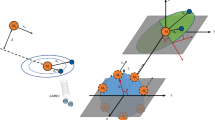Abstract
During the accretion of planets such as Earth, which are formed by collisional accretion of plan-etesimals, the probability of capture of interplanetary bodies in planetocentric orbits is calculated following the approach of Hills (1973) and the n-body simulation, using simplectic integration method. The simulation, taking an input mass equal to about 50% of the present mass of the inner planets, distributed over a large number of planetoids, starting at 4 M y after the formation of solar system, yielded four inner planets within a period of 30 M y. None of these seed bodies, out of which the planets formed, remained at this time and almost 40% mass was transferred beyond 100 AU. Based on these calculations, we conclude that ∼ 1.4 times the mass of the present inner planets was needed to accumulate them. The probability of capture of planetoids in geocentric orbits is found to be negligible. The result emphasizes the computational difficulty in ’probability of capture’ of planetesimals around the Earth before the giant impact. This conclusion, however, is in contradiction to the recent observations of asteroids being frequently captured in transient orbits around the Earth, even when the current population of such interplanetary bodies is smaller by several orders of magnitude compared to the planetary accumulation era.
Similar content being viewed by others
References
Arrhenius G and Lepland A 2000 Accretion of Moon and Earth and the emergence of life;Chemical Geology 169 69–82.
Belbruno E A and Gott J R 2005 Where did the Moon come from?,Astronom. J. 129 1724–1745.
Benz W, Slattery W L and Cameron A G W 1986 The origin of the Moon and the single impact hypothesis I;Icarus 66 515–535.
Benz W, Slattery W L and Cameron A G W 1987 The origin of the Moon and the single impact hypothesis II;Icarus 71 30–45.
Cameron A G W 1986 The impact theory for Origin of the Moon; In:Origin of the Moon (eds) W K Hartmann, R J Phillips and G J Taylor (Houston: Lunar Planet. Insti- tute) pp. 609–616.
Cameron A G W and Ward W R 1976 The origin of the Moon; (abstract) in Lunar Science VII, (Houston: Lunar Science Institute) pp. 120–122.
Canup R M 2004 Formation of the Moon;Ann. Rev. Astron. Astrophys. 42 441–475.
Canup R M and Esposito L W 1996 Accretion of the Moon from an Impact generated Disk;Icarus 119 427–446.
Canup R M and Asphaug E 2001 The Lunar-Forming Giant Impact;Nature 412 708–712.
Chambers J E 1999 A Hybrid Symplectic Integrator that Permits Close Encounters between Massive Bodies;Monthly Notices Royal Astronom. Soc. 304 793–799.
Chambers J E and Wetherill G W 1998 Making the terres- trial planets: N-body integrations of planetary embryos in three dimensions;Icarus 136 304–327.
Hartmann W K 1986 Moon Origin: the Impact trigger hypothesis; In:Origin of the Moon (eds) W K Hartmann, R J Phillips and G J Taylor (Houston: Lunar Planet. Institute) pp. 579–608.
Hartmann W K and Davis D R 1975 Satellite sized plan- etesimals and lunar origin;Icarus 24 504–515.
Hills J G 1973 On the process of Accretion in the formation of the Planets and Comets;Icarus 18 505–522.
Koeberl C, Reimold W U, McDonald I and Rosing M 2000 Search for petrographical and geochemical evidence for late heavy bombardment on Earth in Early Archaen rocks from Isua, Greenland; In:Impacts and the early Earth (eds) I Gilmour and C Koeberl, Lecture Notes in Earth Sciences 91 (Heidelberg: Springer Verlag) pp. 73–97.
Lepland A, van Zuilen M A, Arrhenius G, Whitehouse M J and Fedo C M2005 Questioning the evidence for Earth’s earliest life-Akilia revisited;Geology 33 77–79.
Mojzsis S J, Arrhenius G, McKeegan K D, Harrison T M Nutman A P and Friend R L1996 Evidence for life on Earth before 3800 million years ago;Nature 384 55–59.
Safronov V S 1969 Evolution of the Protoplanetary cloud and formation of the Earth and Planets; (Nauka, Moscow), Translated in 1972 as NASA TT F-677.
Sleep N H, Zahnle K J, Kasting J F and Morowitz H J 1989 Annihilation of ecosystems by large asteroid impacts on the early earth;Nature 342 139–142.
Tera F, Papanastassiou D A and Wasserburg G 1974 Iso- topic evidence for a terminal lunar cataclysm,Earth Planet. Sci. Lett. 22 1–21.
vanZuilen M A, Lepland A and Arrhenius G 2002 Reassess- ing the evidence for the earliest traces of life;Nature 418 627–630.
Wasserburg G J, Papanstassiou D A, Tera F, Huneke F 1977 Outline of a lunar chronology;Trans. Royal. Soc. London 285 7–22.
Wetherill G W 1980 Formation of the Terrestrial Planets;Ann. Rev. Astron. Astrophys. 18 77–113.
Wetherill G W 1986 Accumulating the terrestrial planets and implications concerning lunar origin; In:Origin of the Moon (eds) W K Hartmann, R J Phillips and G J Taylor (Houston: Lunar Planet. Institute) pp. 519–550.
Wetherill G W and Stewart G R 1993 Formation of planetary embryos: Effects of fragmentation, low relative velocity and independent variation of eccentricity and inclination;Icarus 106 190–209.
Wetherill G W 1975 Late heavy bombardment of the Moon and terrestrial planets;Proc. Lunar Sci. Conf. 6th, pp. 1539-1561.
Wieczorek M A and Phillips R J 1999 Lunar Multi ring basins and the cratering process;Icarus 139 246–259.
Williams K K and Zuber M T 1998 Measurement and Analysis of Lunar Basin Depths from Clementine Altime- try;Icarus 131 107–122.
Zahnle K J and Sleep N H 1997 Impacts and the early evo- lution of life; In:Comets and the origin and evolution of life (eds) P J Thomas, C F Chyba and C P Mc Kay (New York: Springer Verlag) pp. 175–208.
Author information
Authors and Affiliations
Rights and permissions
About this article
Cite this article
Shivakumar, M., Bhandari, N. Capture of interplanetary bodies in geocentric orbits and early lunar evolution. J Earth Syst Sci 114, 601–607 (2005). https://doi.org/10.1007/BF02715943
Issue Date:
DOI: https://doi.org/10.1007/BF02715943




